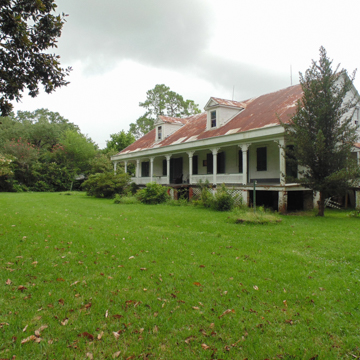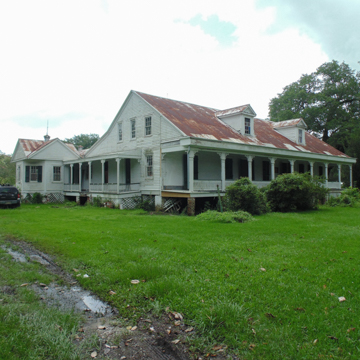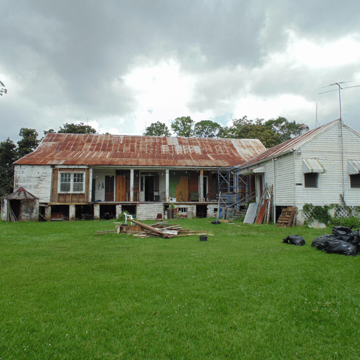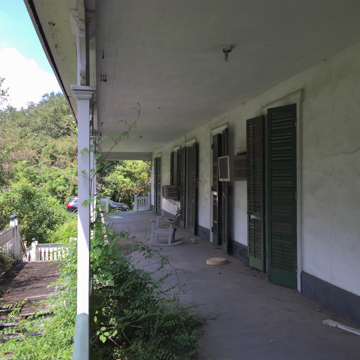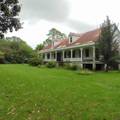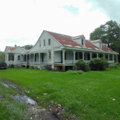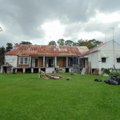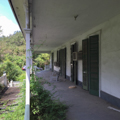Woodland Plantation
The Woodland Plantation House represents over a century of architectural tastes and shifting economic influences on a south Louisiana sugar plantation. The side-gabled, one-and-a-half-story structure is raised on brick piers and features a stuccoed front and weatherboarded sides and rear. The original building was a two-room (salle and chamber) Creole core constructed of bousillage circa 1793 for Manuel Andry. This was expanded in the 1810s for François Nobert Boudousquie, resulting in a four-room house with front, rear, and side galleries. The 1840s brought even further expansion and stylistic updates under the ownership of the Hollingsworth family. This work is distinguished by sawn, rather than hewn, wall posts and less densely applied bousillage. The addition of two rooms, the enclosure of the rear loggia, and the filling in of some openings resulted in an eight-bay house with two ranges of rooms. In typical Creole fashion, the plan lacks a hall and the rear contains smaller rooms than the front. The remodeled house was finished with battered crossette casings in the Greek Revival style. The fourth and final campaign of alterations occurred circa 1898, and included the addition of two dormers with scallop-shingled gables on the front roof slope, and sawnwork brackets and balustrades on the front gallery. With these additions, Woodland Plantation’s facade offers a decidedly Victorian-era appearance that belies the Greek Revival casings, plaster-covered bousillage walls, and Creole plan just beyond.
Along with its architecture, Woodland Plantation was also a place of significant social history. It should not be confused with another Louisiana plantation of the same name known for its representation on the Southern Comfort label from the 1930s until 2010. Rather, it was at this Woodland Plantation where Haitian-born Charles Deslondes initiated a revolt against the enslavers of St. John the Baptist Parish, an insurgency that grew to include more than 500 enslaved persons—the largest in United States history. In 2019, artist Dread Scott led a reenactment of this important event.
Woodland Plantation was also the birthplace of the influential jazz musician Edward “Kid” Ory (1886–1973). In his early life, Ory and his friends made their own instruments and played music together at Woodland. By the 1910s, Ory had moved to New Orleans and led one of the city’s best-known jazz bands. Ory’s musical legacy remains rooted in the Creole world of his Woodland upbringing. Today, Woodland Plantation remains privately owned.
References
Begue, Gabrielle, “Woodland Plantation,” St. John the Baptist Parish, Louisiana. National Register of Historic Places Registration Form, 2017. National Park service, U.S. Department of the Interior, Washington, D.C.
Rasmussen, Daniel. American Uprising: The Untold Story of America’s Largest Slave Revolt. New York: Harper Collins, 2011.
McCusker, John. Creole Trombone: Kid Ory and the Early Years of Jazz. Jackson: University of Mississippi, 2012.
Writing Credits
If SAH Archipedia has been useful to you, please consider supporting it.
SAH Archipedia tells the story of the United States through its buildings, landscapes, and cities. This freely available resource empowers the public with authoritative knowledge that deepens their understanding and appreciation of the built environment. But the Society of Architectural Historians, which created SAH Archipedia with University of Virginia Press, needs your support to maintain the high-caliber research, writing, photography, cartography, editing, design, and programming that make SAH Archipedia a trusted online resource available to all who value the history of place, heritage tourism, and learning.




















